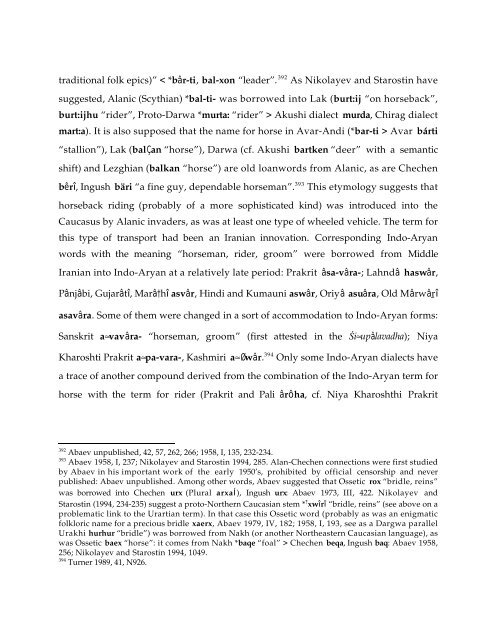Comparative Notes on Hurro-Urartian, Northern Caucasian
Comparative Notes on Hurro-Urartian, Northern Caucasian
Comparative Notes on Hurro-Urartian, Northern Caucasian
Create successful ePaper yourself
Turn your PDF publications into a flip-book with our unique Google optimized e-Paper software.
traditi<strong>on</strong>al folk epics)” < *bâr-ti, bal-x<strong>on</strong> “leader”. 392 As Nikolayev and Starostin have<br />
suggested, Alanic (Scythian) *bal-ti- was borrowed into Lak (burt:ij “<strong>on</strong> horseback”,<br />
burt:ijhu “rider”, Proto-Darwa *murta: “rider” > Akushi dialect murda, Chirag dialect<br />
mart:a). It is also supposed that the name for horse in Avar-Andi (*bar-ti > Avar bárti<br />
“stalli<strong>on</strong>”), Lak (balÇan “horse”), Darwa (cf. Akushi bartken “deer” with a semantic<br />
shift) and Lezghian (balkan “horse”) are old loanwords from Alanic, as are Chechen<br />
bêrî, Ingush bäri “a fine guy, dependable horseman”. 393 This etymology suggests that<br />
horseback riding (probably of a more sophisticated kind) was introduced into the<br />
Caucasus by Alanic invaders, as was at least <strong>on</strong>e type of wheeled vehicle. The term for<br />
this type of transport had been an Iranian innovati<strong>on</strong>. Corresp<strong>on</strong>ding Indo-Aryan<br />
words with the meaning “horseman, rider, groom” were borrowed from Middle<br />
Iranian into Indo-Aryan at a relatively late period: Prakrit âsa-vâra-; Lahndâ haswâr,<br />
Pânjâbi, Gujarâtî, Marâ†hî asvâr, Hindi and Kumauni aswâr, Oriyâ asuâra, Old Mârwâr=î<br />
asavâra. Some of them were changed in a sort of accommodati<strong>on</strong> to Indo-Aryan forms:<br />
Sanskrit a≈vavâra- “horseman, groom” (first attested in the Íi≈upâlavadha); Niya<br />
Kharoshti Prakrit a≈pa-vara-, Kashmiri a≈Øwâr. 394 Only some Indo-Aryan dialects have<br />
a trace of another compound derived from the combinati<strong>on</strong> of the Indo-Aryan term for<br />
horse with the term for rider (Prakrit and Pali ârôha, cf. Niya Kharoshthi Prakrit<br />
392 Abaev unpublished, 42, 57, 262, 266; 1958, I, 135, 232-234.<br />
393 Abaev 1958, I, 237; Nikolayev and Starostin 1994, 285. Alan-Chechen c<strong>on</strong>necti<strong>on</strong>s were first studied<br />
by Abaev in his important work of the early 1950’s, prohibited by official censorship and never<br />
published: Abaev unpublished. Am<strong>on</strong>g other words, Abaev suggested that Ossetic rox “bridle, reins”<br />
was borrowed into Chechen urx (Plural arxaÍ), Ingush urx: Abaev 1973, III, 422. Nikolayev and<br />
Starostin (1994, 234-235) suggest a proto-<strong>Northern</strong> <strong>Caucasian</strong> stem * ? xwîrî “bridle, reins” (see above <strong>on</strong> a<br />
problematic link to the <strong>Urartian</strong> term). In that case this Ossetic word (probably as was an enigmatic<br />
folkloric name for a precious bridle xaerx, Abaev 1979, IV, 182; 1958, I, 193, see as a Dargwa parallel<br />
Urakhi hurhur “bridle”) was borrowed from Nakh (or another Northeastern <strong>Caucasian</strong> language), as<br />
was Ossetic baex “horse”: it comes from Nakh *baqe “foal” > Chechen beqa, Ingush baq: Abaev 1958,<br />
256; Nikolayev and Starostin 1994, 1049.<br />
394 Turner 1989, 41, N926.





